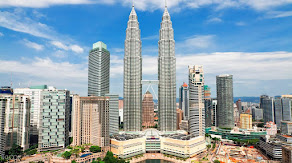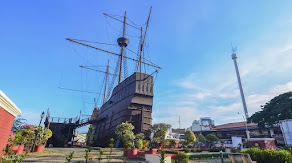Kuala Lumpur locally often abbreviated as K.L., is the capital and largest city of Malaysia. The city proper, making up an area of 244 km2 (94 sq mi), has an estimated population of 1.6 million in 2006. Greater Kuala Lumpur, also known as the Klang Valley, is an urban agglomeration of 7.2 million. It is the fastest growing metropolitan region in the country, in terms of population as well as economy.

Kuala Lumpur is the seat of the Parliament of Malaysia. The city was once home to the executive and judicial branches of the federal government, but they have since moved to Putrajaya starting in 1999. Some sections of the judiciary remain in the capital. The official residence of the Malaysian King, the Istana Negara, is also situated in Kuala Lumpur. The city is also the cultural and economic centre of Malaysia due to its position as the capital as well as being a primate city. Kuala Lumpur is rated as an alpha world city, and is the only global city in Malaysia, according to the Globalization and World Cities Study Group and Network (GaWC).
 Kuala Lumpur is defined within the borders of the Federal Territory of Kuala Lumpur and is one of three Malaysian Federal Territories. It is an enclave within the state of Selangor, on the central west coast of Peninsular Malaysia. Residents of the city are known as KLites.
Kuala Lumpur is defined within the borders of the Federal Territory of Kuala Lumpur and is one of three Malaysian Federal Territories. It is an enclave within the state of Selangor, on the central west coast of Peninsular Malaysia. Residents of the city are known as KLites.
Beginning in the 1990s, the city has played host to many international sporting, political and cultural events including the 1998 Commonwealth Games and the Formula One World Championship.In addition, Kuala Lumpur is home to the tallest twin buildings in the world, the Petronas Twin Towers.
History
Kuala Lumpur has its origins in the 1850s, when the Malay Chief of Klang, Raja Abdullah, hired some Chinese labourers to open new and larger tin mines. They landed at the confluence of Sungai Gombak and Sungai Klang (Klang River) to open mines at Ampang. Sungai Gombak was previously known as Sungai Lumpur, which means muddy river. The Original name for this city was "Pengkalan Lumpur", which means bundle of mud. As time passes by the name changed to Kuala Lumpur which literally means “muddy confluence” in Bahasa Melayu. Later, tin mines were opened at Pudu and Batu. Among the early notable pioneers are Hiu Siew and Liu Ngim Kong. 
These mines developed into a trading post which became to be considered a frontier town. Early Kuala Lumpur had many problems, including the Selangor Civil War; it was also plagued by diseases and constant fires and floods. Around the 1870s, the Chinese Kapitan of Kuala Lumpur, Yap Ah Loy, emerged as leader, and became responsible for the survival and subsequent systematic growth of this town. He began to develop Kuala Lumpur from a small unknown place into a mining town with economic boom. In 1880, the state capital of Selangor was moved from Klang to the more strategically advantageous Kuala Lumpur.
In 1881, a flood swept through the town following a fire which engulfed it earlier. These successive problems destroyed the town's structures of wood and atap (thatching). As a response, Frank Swettenham, the British Resident of Selangor, required that buildings be constructed of brick and tile. Many of the new brick buildings mirrored that of shop houses in southern China, with "five foot ways" as well as skilled Chinese carpentry. This resulted in a distinct eclectic shop house architecture typical to this region. A railway line increased accessibility into this town. Development intensified in the 1890s, leading to the creation of a Sanitary Board. In 1896, Kuala Lumpur was chosen as the capital of the newly formed Federated Malay States.

These mines developed into a trading post which became to be considered a frontier town. Early Kuala Lumpur had many problems, including the Selangor Civil War; it was also plagued by diseases and constant fires and floods. Around the 1870s, the Chinese Kapitan of Kuala Lumpur, Yap Ah Loy, emerged as leader, and became responsible for the survival and subsequent systematic growth of this town. He began to develop Kuala Lumpur from a small unknown place into a mining town with economic boom. In 1880, the state capital of Selangor was moved from Klang to the more strategically advantageous Kuala Lumpur.
In 1881, a flood swept through the town following a fire which engulfed it earlier. These successive problems destroyed the town's structures of wood and atap (thatching). As a response, Frank Swettenham, the British Resident of Selangor, required that buildings be constructed of brick and tile. Many of the new brick buildings mirrored that of shop houses in southern China, with "five foot ways" as well as skilled Chinese carpentry. This resulted in a distinct eclectic shop house architecture typical to this region. A railway line increased accessibility into this town. Development intensified in the 1890s, leading to the creation of a Sanitary Board. In 1896, Kuala Lumpur was chosen as the capital of the newly formed Federated Malay States.
A mixture of different communities settled in various sections of Kuala Lumpur. The Chinese mainly settled around the commercial centre of Market Square, east of Klang River, and towards Chinatown. The Malays, Indian Chettiars, and Indian Muslims resided along Java Street (now Jalan Tun Perak). The Padang, now known as Merdeka Square, was the center of the British administrative offices.
During World War II, Kuala Lumpur was captured by the Japanese army on January 11, 1942. They remained in occupation until August 15, 1945, when the commander in chief of the Japanese Seventh Area Army in Singapore and Malaya, Seishirō Itagaki, surrendered to the British administration following the Atomic bombings of Hiroshima and Nagasaki. Kuala Lumpur grew through the war, the rubber and tin commodity crashes and the Malayan Emergency, during which Malaya was preoccupied with the communist insurgency.[ In 1957, the Federation of Malaya gained its independence from British rule. Kuala Lumpur remained the capital through the formation of Malaysia on September 16, 1963.
On May 13, 1969, one of the worst race riots in Malaysia took place in Kuala Lumpur. The May 13 Incident was a riot between the Malays and the Chinese. The former being dissatisfied with their socio-political situation at the time. The riot resulted in the deaths of 196 people, and led to a major reform in the country's economic policy favouring the Malays.
Kuala Lumpur later achieved city status in 1972, becoming the first settlement in Malaysia to be granted the status after independence. Later, on February 1, 1974, Kuala Lumpur became a Federal Territory. Kuala Lumpur ceased to be the capital of Selangor in 1978 after the city of Shah Alam was declared as the new state capital.
On May 13, 1969, one of the worst race riots in Malaysia took place in Kuala Lumpur. The May 13 Incident was a riot between the Malays and the Chinese. The former being dissatisfied with their socio-political situation at the time. The riot resulted in the deaths of 196 people, and led to a major reform in the country's economic policy favouring the Malays.
Kuala Lumpur later achieved city status in 1972, becoming the first settlement in Malaysia to be granted the status after independence. Later, on February 1, 1974, Kuala Lumpur became a Federal Territory. Kuala Lumpur ceased to be the capital of Selangor in 1978 after the city of Shah Alam was declared as the new state capital.
On 14 May 1990, Kuala Lumpur was celebrated 100 years of local authority. The new federal territory of Kuala Lumpur flag and anthem were introduced.
 In 1998, another political movement known as Reformasi took place mainly in this city.The movement was a result of the sacking of former Malaysian Deputy Prime Minister, Anwar Ibrahim, and resulted in a chain of protests until 1999, where supporters of Anwar Ibrahim took to the streets to demand reforms in the government's administration, among others.
In 1998, another political movement known as Reformasi took place mainly in this city.The movement was a result of the sacking of former Malaysian Deputy Prime Minister, Anwar Ibrahim, and resulted in a chain of protests until 1999, where supporters of Anwar Ibrahim took to the streets to demand reforms in the government's administration, among others.
On February 1, 2001, Putrajaya was declared a Federal Territory, as well as the seat of the federal government. The administrative and judicial functions of the government were shifted from Kuala Lumpur to Putrajaya. Kuala Lumpur however still retained its legislative function, and remained the home of the Yang di-Pertuan Agong (King).
Geography
 In 1998, another political movement known as Reformasi took place mainly in this city.The movement was a result of the sacking of former Malaysian Deputy Prime Minister, Anwar Ibrahim, and resulted in a chain of protests until 1999, where supporters of Anwar Ibrahim took to the streets to demand reforms in the government's administration, among others.
In 1998, another political movement known as Reformasi took place mainly in this city.The movement was a result of the sacking of former Malaysian Deputy Prime Minister, Anwar Ibrahim, and resulted in a chain of protests until 1999, where supporters of Anwar Ibrahim took to the streets to demand reforms in the government's administration, among others.On February 1, 2001, Putrajaya was declared a Federal Territory, as well as the seat of the federal government. The administrative and judicial functions of the government were shifted from Kuala Lumpur to Putrajaya. Kuala Lumpur however still retained its legislative function, and remained the home of the Yang di-Pertuan Agong (King).
Geography






